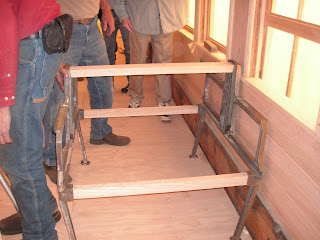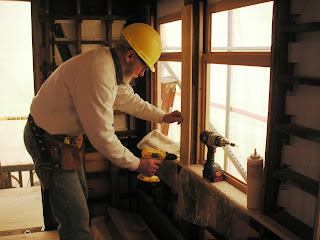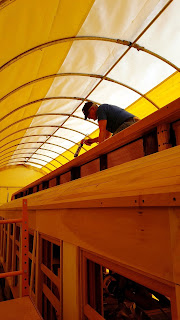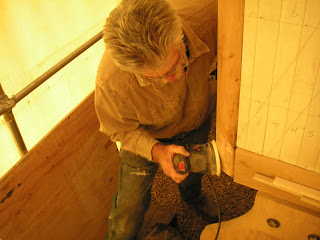Before the interior panelling can be put up these triangular glue blocks were fastened to the framing and small panels within the the framing which provide stability from shear.
This photo shows placement of the blocks which were both glued and nailed in place.
The interior walls are covered with tongue and groove oak as seen here. At the right edge of the photo is a piece of the trim that will go above at the junction of the wall and ceiling.
The boards were bevelled where the ends met.
Some of the boards covered hardware and had to be fitted over projecting nuts, etc. Here Mike is chiseling a pocket in one of the boards.
Furring strips were placed at the ends of the car for the paneling.
One side is done.
Now Don and Mike are putting up the other side, the south I believe.
Ron is back from sunny Arizona and is putting up the paneling on the end of the car.
This photo taken in mid April looking toward the west end of the car shows the walls are nearly complete.
Here is a close-up view of a corner.
A door was temporarily fitted to its opening to work out how the finishing trim could be done around the door. The two doors have been in the car recently, and here Craig is removing the stabilizing braces before moving the door.
The door makes it look more finished.
In the last post we saw some of the details of the coupler mechanism. This photo shows a copy of a drawing made by Glen for one of the steel pieces of the coupler pocket. Joe fabricated the piece from this drawing.
The orange piece in this photo was made from the above drawing.
Meanwhile, work continued on fitting the steel brackets to the steel on the inner sills of the car. Bill L. and Bill K. are under the car. The space is tight, but better than without a pit. Hard hats are advised.
Some drilling was necessary, and John is adjusting the magnetic drill.
Some of the seat frame castings have been delivered so we had a demonstration on how the seats are set up.
Spacer boards are inserted between the two castings in pockets in the castings.
This photo shows the framing.
The seat and back pieces which are hinged together are inserted in grooves in the castings as shown here.
The back of the seat assembly rides up the grooves and the configuration for passengers sitting is shown here. The back can be slid down again and the seat moved forward, which together with the facing seat, can make a berth for sleeping.
As of this posting, John Weiss tells us that all of the castings have been completed by the foundry in Texas.
Thanks again to John Engs for help with the photos.



































































